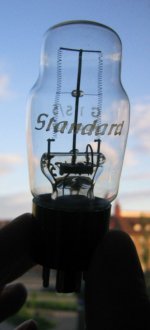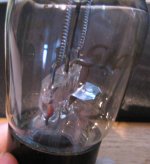are you really sure?

seriously, of course it can be just a lightbulb, but why are there something like a getter-plate connected to one of the pins?
I was thinking it was a "slow-start" kind of gizmo or a series-filament-thingie..

seriously, of course it can be just a lightbulb, but why are there something like a getter-plate connected to one of the pins?
I was thinking it was a "slow-start" kind of gizmo or a series-filament-thingie..
Mmm... some ballast kind of thing, or even a very strange gas tube if you say it has a plate... however, from the photo, no signs of getter or plates.
Have you tried to light it up? Maybe firstly measure DC resistance of the filament, just to make a rought guess on what voltage this is supposed to run.
Have you tried to light it up? Maybe firstly measure DC resistance of the filament, just to make a rought guess on what voltage this is supposed to run.
It may very well be used for signal compression. Used in the same incandescent bulbs are/were.
Perhaps for gain control in early radio recievers ot transmitters as well.
Just guessing...
Perhaps for gain control in early radio recievers ot transmitters as well.
Just guessing...
due to the particular use of pin 2 and 7, can it just be a "dummy-load" for a series-filament tube, during faultfinding?
Is the pin running down the center a conductor?
Is the center pin connected to an external base/socket pin?
Is the donut in the center (around the pin) an insulator?
What type of base for the tube?
Is the center pin connected to an external base/socket pin?
Is the donut in the center (around the pin) an insulator?
What type of base for the tube?
The word "baretter" popped into my head.
But I can't remember what they were used for.
Cheers
Rob
But I can't remember what they were used for.
Cheers
Rob
I think that it is a barreter, can't even remember if that is how they are spelt.
I used to be a technician in British Telecom many moons ago, and when I was an apprentice we used to have to change the things.
They were used as current limiters in subs circuits. They are basically light bulbs.
hope that helps.
bill
I used to be a technician in British Telecom many moons ago, and when I was an apprentice we used to have to change the things.
They were used as current limiters in subs circuits. They are basically light bulbs.
hope that helps.
bill
It looks like a barreter to me too. I have an AC/DC Phillips radio that was wired by a madman that uses one. It performs current limiting for the series filament circuit, necessary because of the wide range of voltages the thing may get plugged into.
It has no transformer you know, a live chassis. They don't do things like that anymore...
It has no transformer you know, a live chassis. They don't do things like that anymore...
shall we say that concludes it?, its a baretter..
rather worthless thingie in my amps, but hey, its a beauty on the bookshelf 😎
Thank you guys!
rather worthless thingie in my amps, but hey, its a beauty on the bookshelf 😎
Thank you guys!
I think it looks like a barretter (two "t"s). As previously mentioned in this thread, they were used in telegraph circuits as short-circuit protection and glowed like lightbulbs when driven into a short-circuit. The difference between them and a lightbulb is that instead of the bulb being evacuated, it's filled with nitrogen. The other use of their non-linear resistance was in series heater chains to keep the current constant.
I have a few flimsier versions and hadn't previously seen such a beefy example.
I have a few flimsier versions and hadn't previously seen such a beefy example.
I got a variety of different models in my stock, I have seen them in some old radios and stuff, used for regulation and ballast I think.
I got models from 90v up to 220v some big and some small
I got models from 90v up to 220v some big and some small
The difference between them and a lightbulb is that instead of the bulb being evacuated, it's filled with nitrogen.
Here in the United States, ballast tubes (barretters) are filled with either hydrogen or helium and are used as current and voltage regulators. They are still available from Amperite. Light bulbs here are generally filled with a noble gas under low pressure, so the main difference between the two is that the ballast tube generally has a higher resistance filiment and doesn't glow as brightly.
John
- Status
- Not open for further replies.
- Home
- Amplifiers
- Tubes / Valves
- strange tube G1 S/5

